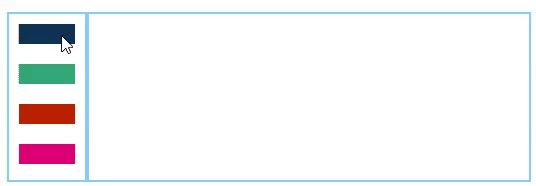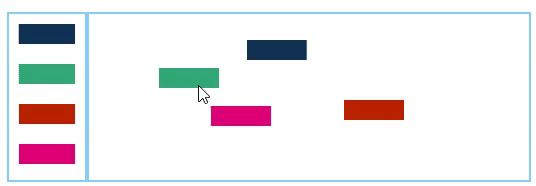WPF 应用 - 拖拽窗体、控件
1. 拖拽窗体
使用 System.Windows.Window 自带的 DragMove() 方法即可识别窗体拖动。
DragMove();
2. 拖拽控件:复制、移动控件
<Grid>
<Grid.ColumnDefinitions>
<ColumnDefinition Width="*"/>
<ColumnDefinition Width="5*"/>
</Grid.ColumnDefinitions>
<Grid.Resources>
<Style TargetType="Rectangle">
<Setter Property="Width" Value="60"/>
<Setter Property="Height" Value="20"/>
<Setter Property="Margin" Value="10"/>
</Style>
</Grid.Resources>
<Border Grid.Column="0" BorderBrush="LightSkyBlue" BorderThickness="2" MouseLeftButtonDown="Add_MouseLeftButtonDown">
<StackPanel x:Name="sp">
<Rectangle Fill="#FF113355"/>
<Rectangle Fill="#FF33AA77"/>
<Rectangle Fill="#FFBB2200"/>
<Rectangle Fill="#FFDD0077"/>
</StackPanel>
</Border>
<Border Grid.Column="1" BorderBrush="LightSkyBlue" BorderThickness="2" MouseLeftButtonDown="Move_MouseLeftButtonDown">
<Canvas x:Name="cav">
</Canvas>
</Border>
</Grid>
...
public partial class VisualWindow : Window
{
public VisualWindow()
{
InitializeComponent();
}
Rectangle SelectedRect { get; set; }
/// <summary>
/// 如果点击右侧可新增的矩形,则右侧 Canvas 将新增一个矩形
/// </summary>
private void Add_MouseLeftButtonDown(object sender, MouseButtonEventArgs e)
{
Point point = e.GetPosition(this.sp);
if (e.Source.GetType() != typeof(Rectangle)) return;
InitRectangle((Rectangle)e.Source);
this.cav.Children.Add(SelectedRect);
this.MouseMove += VisualWindow_MouseMove;
this.MouseLeftButtonUp += VisualWindow_MouseLeftButtonUp;
}
/// <summary>
/// 将 SelectedRect 指向一个新的 Rectangle
/// </summary>
private void InitRectangle(Rectangle rect)
{
SelectedRect = new Rectangle();
SelectedRect.Width = rect.Width;
SelectedRect.Height = rect.Height;
SelectedRect.Fill = rect.Fill;
SelectedRect.Opacity = 0;
}
/// <summary>
/// 如果目标被拖入指定区域,opacity 设为 0.5,并跟随鼠标,直到鼠标释放或鼠标离开指定区域
/// </summary>
private void VisualWindow_MouseMove(object sender, MouseEventArgs e)
{
if (SelectedRect == null) return;
Point point = e.GetPosition(this.cav);
if (point.X < 0 || point.Y < 0)
{
SelectedRect.Opacity = 0;
return;
}
SelectedRect.Opacity = 0.5;
Canvas.SetLeft(SelectedRect, point.X - SelectedRect.Width / 2);
Canvas.SetTop(SelectedRect, point.Y - SelectedRect.Height / 2);
}
/// <summary>
/// 如鼠标离开指定区域(这里可以简单以 SelectedRect.Opacity == 0 作为标记),则移除刚新增的矩形
/// 如鼠标在指定区域释放,则将新增的矩形停在鼠标释放的位置
/// </summary>
private void VisualWindow_MouseLeftButtonUp(object sender, MouseButtonEventArgs e)
{
Point point = e.GetPosition(this.cav);
bool isMouseOutOfCav = point.X < 0 || point.Y < 0;
if (SelectedRect != null && isMouseOutOfCav)
{
this.cav.Children.Remove(SelectedRect);
}
SelectedRect.Opacity = 1;
this.MouseMove -= VisualWindow_MouseMove;
this.MouseLeftButtonUp -= VisualWindow_MouseLeftButtonUp;
}
/// <summary>
/// 移动矩形
/// </summary>
private void Move_MouseLeftButtonDown(object sender, MouseButtonEventArgs e)
{
if (e.Source.GetType() != typeof(Rectangle)) return;
SelectedRect = (Rectangle)e.Source;
this.MouseMove += VisualWindow_MouseMove;
this.MouseLeftButtonUp += VisualWindow_MouseLeftButtonUp;
}
}
效果:





 浙公网安备 33010602011771号
浙公网安备 33010602011771号